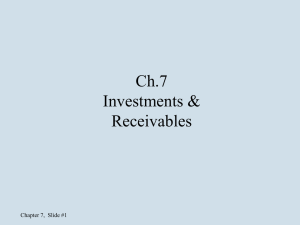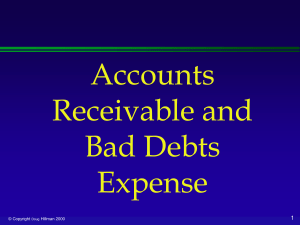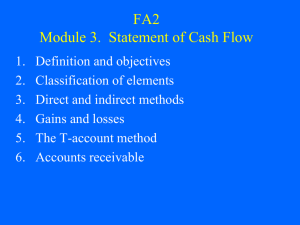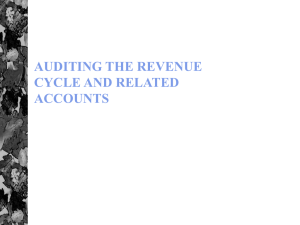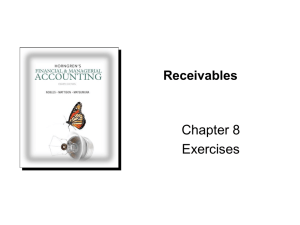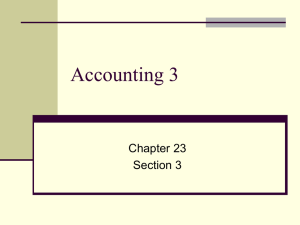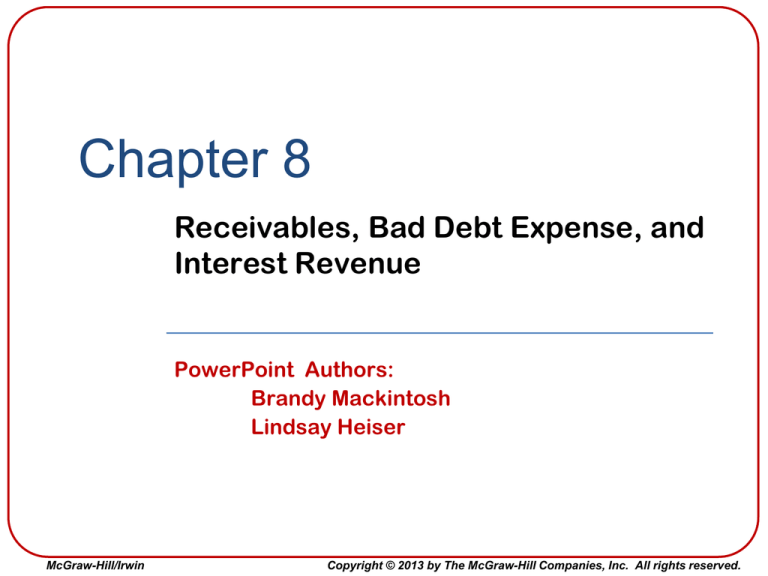
Chapter 8
Receivables, Bad Debt Expense, and
Interest Revenue
PowerPoint Authors:
Brandy Mackintosh
Lindsay Heiser
McGraw-Hill/Irwin
Copyright © 2013 by The McGraw-Hill Companies, Inc. All rights reserved.
Learning Objective 8-1
Describe the trade-offs of
extending credit.
8-2
Pros and Cons of Extending Credit
Advantage
1. Increases the seller’s revenues.
Disadvantages
1. Increased wage costs.
2. Bad debt costs.
3. Delayed receipt of cash.
8-3
Learning Objective 8-2
Estimate and report the effects
of uncollectible accounts.
8-4
Accounts Receivable and Bad Debts
Jan. 1
Record sales on account
Bad debt known
dr Accounts Receivable
cr Sales Revenue
Balance Sheet
8-5
Income Statement
Cash
Sales Revenue
Accounts Receivable
Cost of Goods Sold
Inventory
Gross Profit
…
…
Accounts Receivable and Bad Debts
Jan. 1
Jan. 31
Record sales on account
dr Accounts Receivable
cr Sales Revenue
Record estimate of bad debts
dr Bad Debt Expense (+E, -SE)
cr Allowance for Doubtful Accounts (+xA, -A)
Balance
Sheet
Balance
Sheet
8-6
Bad debt known
Income Statement
Cash
Cash
Accounts
Receivable
Accounts Receivable
Less: Allowance for Doubtful Accounts
Inventory
Accounts Receivable, Net
Sales Revenue
…
Inventory
… Debt Expense
Bad
…
…
Cost of Goods Sold
Gross Profit
Accounts Receivable and Bad Debts
Jan. 1
Jan. 31
Record sales on account
dr Accounts Receivable
cr Sales Revenue
Balance
Sheet
Balance
Sheet
Cash
Cash
Accounts
Receivable
Accounts Receivable
Less: Allowance for Doubtful Accounts
Inventory
Accounts Receivable, Net
…
Inventory
…
8-7
Record estimate of bad debts
Bad debt known
dr Bad Debt Expense (+E, -SE)
cr Allowance for Doubtful Accounts (+xA, -A)
dr Allowance for Doubtful Accounts (-xA)
cr Accounts Receivable(-A)
Allowance Method
The allowance method follows a two-step
process, described below:
1. Make an end-of-period adjustment to
record the estimated bad debts in the
period credit sales occur.
2. Remove (“write off”) specific customer
balances when they are known to be
uncollectible.
8-8
1. Adjust for Estimated Bad Debts
Assume that VFC estimates $900 in bad debts at
the end of the accounting period.
1 Analyze
Assets
Allowance for Doubtful
Accounts (+xA) -900
2
Liabilities
Stockholders’ Equity
+
Bad Debt
Expense (+E)
-900
Record
dr
8-9
=
Bad Debt Expense (+E, -SE)
cr Allowance for Doubtful Accounts (+xA, -A)
900
900
1. Adjust for Estimated Bad Debts
8-10
2. Remove (Write-off) Specific Customer Balances
VFC writes off $800 receivable from Fast Fashions because
the company could not pay its account.
1 Analyze
Assets
=
Liabilities
+
Stockholders’ Equity
Allowance for Doubtful
Accounts (-xA) +800
Accounts
Receivable (-A)
-800
2
Record
dr
8-11
Allowance for Doubtful Accounts (-xA, +A)
cr Accounts Receivable (-A)
800
800
2. Remove (Write-off) Specific Customer Balances
Bad Debt Expense (+E, -SE)
cr Allowance for Doubtful Accounts (+xA, -A)
900
Allowance for Doubtful Accounts (-xA, +A)
cr Accounts Receivable (-A)
800
dr
dr
Accounts Receivable (A)
dr +
1/1 Bal.
900
800
cr -
200,000
1/31 Bal. 200,000
800 (2) Write-off
2/28 Bal. 199,200
dr -
Allow. For Doubtful Accts. (xA)
cr +
1/1 Bal.
14,100
900 (1) Estimate
(2) Write -off
8-12
15,000
1/31 Bal.
14,200
2/28 Bal.
800
dr +
Bad Debt Expene (E, SE)
1/1 Bal.
(1) Estimate
0
900
1/31 Bal.
900
cr -
Methods for Estimating Bad Debts
There are two acceptable methods of estimating
the bad debts in a given period.
1. Percentage of Credit Sales Method.
2. Aging of Accounts Receivable.
Simpler to apply.
More accurate
8-13
Percentage of Credit Sales Method
The percentage of credit sales method
estimates bad debt expense by
multiplying the historical percentage of
bad debt losses by the current period’s
credit sales.
8-14
Percentage of Credit Sales Method
VFC has experienced bad debt losses of ¾ of 1
percent of credit sales in prior periods. Credit sales in
January total $120,000,
Credit sales for January
Historical bad debt rate
Bad debt expense for January
2
Record
dr
8-15
$ 120,000
0.75%
$
900
Bad Debt Expense (+E, -SE)
cr Allowance for Doubtful Accounts (+xA, -A)
900
900
Aging of Accounts Receivable
While the percentage of credit sales method focuses on
estimating Bad Debt Expense (income statement approach) for
the period, the aging of accounts receivable method focuses on
estimating the ending balance in the Allowance for Doubtful
Accounts (balance sheet approach).
The aging method gets its name because it is based on the
“age” of each amount in Accounts Receivable at the end of the
period. The older and more overdue an account receivable
becomes, the less likely it is to be collectible.
8-16
Aging of Accounts Receivable
VFC applies the aging of accounts receivable method to its Accounts
Receivable balances when its quarter ends on March 31. The
method includes three steps: (1) Prepare an aged list of accounts
receivable, (2) Estimate bad debt loss percentages for each category,
and (3) Compute the total estimated bad debts.
Step
1
8-17
Age Accounts Receivable.
Aging of Accounts Receivable
Step
2
8-18
Estimate bad debt loss percentages for each category.
Aging of Accounts Receivable
Step
3
8-19
Compute the total estimated bad debts.
Aging of Accounts Receivable
AJE = ($17,240 - $14,200) = $3,040
8-20
Aging of Accounts Receivable
Prepare the AJE for Bad Debt Expense at March 31.
1 Analyze
Assets
=
Liabilities
Allowance for Doubtful
Accounts (+xA) -2,240
2
Bad Debt
Expense (+E)
-2,240
Record
dr
3
Bad Debt Expense (+E, -SE)
cr Allowance for Doubtful Accounts (+xA, -A)
2,240
2,240
Summarize
dr - Allow. For Doubtful Accts (xA) cr +
8-21
Stockholders’ Equity
+
dr +
Bad Debt Expense (E,SE)
15,000
2,240
Unadj. Bal.
AJE
Beg. Bal.
AJE
900
2,240
17,240
Adj. Bal.
End Bal.
3,140
cr -
Other Issues
Revising Estimates -- Bad debt estimates always differ
from the amounts that are later written off. If these
differences are material, companies are required to
revise their bad debt estimates for the current period.
Account Recoveries -- Collection of a previously written
off account is called a recovery and it is accounted for in
two parts. First, put the receivable back on the books by
recording the opposite of the write-off. Second, record
the collection of the account.
8-22
Other Issues
Let’s assume that VFC collects the $800 from Fast Fashions that
was previously written off. This recovery would be recorded with
the following journal entries:
(1) Reverse the write-off.
(2) Record the collection.
8-23
Learning Objective 8-3
Compute and report interest
on notes receivable.
8-24
Notes Receivable and Interest Revenue
A company reports Notes Receivable if it uses a
promissory note to document its right to collect money
from another party.
Unlike accounts receivable, which are interest free until
they become overdue, notes receivable charge interest
from the day they are created to the day they are due
(their maturity date).
8-25
Calculating Interest
Interest (I) = Principal (P) × Interest Rate (R) × Time (T)
The amount of the
note receivable
8-26
The annual interest rate
charged on the note
The time period for
interest calculation
Recording Notes Receivable and Interest Revenue
The four key events that occur with any note receivable are:
Date of Note Receivable
Annual Interest Rate
Amount of the Note
Maturity Date of Note
Year End of Company
8-27
November 1, 2012
6%
$100,000
October 31, 2013
December 31, 2012
(1) Establishing a Note Receivable
Assume that on November 1, 2012, VFC lent $100,000 to a company by
creating a note that required the company to pay VFC 6 percent interest
and the $100,000 principal on October 31, 2013.
1 Analyze
Assets
=
Liabilities
+
Stockholders’ Equity
Notes Receivable +100,000
Cash -100,000
2
Record
dr
8-28
Notes Receivable (+A)
cr Cash (-A)
100,000
100,000
(2) Accruing Interest Earned
Accrue the interest earned at year-end, December 31, 2012.
Principal (P) × Interest Rate (R) × Time (T) = Interest (I)
$100,000 × 6% × 2/12 = $1,000
8-29
(2) Accruing Interest Earned
Accrue the interest earned at year-end, December 31, 2012.
1 Analyze
Assets
Interest
Receivable
2
Liabilities
(+A) +1,000
+
Stockholders’ Equity
Interest Revenue
(+R, +SE) +1,000
Record
dr
8-30
=
Interest Receivable (+A)
cr Interest Revenue (+R, +SE)
1,000
1,000
(3) Record Interest Received
Record interest received at maturity, October 31, 2013.
Principal (P) × Interest Rate (R) × Time (T) = Interest (I)
$100,000 × 6% × 12/12 = $6,000
8-31
(3) Record Interest Received
Record interest received at maturity, October 31, 2013.
1 Analyze
Assets
=
Liabilities
Cash (+A) +6,000
Interest
Receivable (-A) -1,000
+
Stockholders’ Equity
Interest
Revenue (+R, +SE) +5,000
$5,000 = $100,000 × 6% × 10/12
2
Record
dr
8-32
Cash (+A)
cr Interest Receivable (-A)
cr Interest Revenue (+R, +SE)
6,000
1,000
5,000
(4) Recording Principal Received
The principal amount of the note is received on October 31, 2013.
1 Analyze
Assets
=
Liabilities
+
Stockholders’ Equity
Cash (+A) +100,000
Note
Receivable (-A) -100,000
2
Record
dr
8-33
Cash (+A)
cr Note Receivable (-A)
100,000
100,000
Learning Objective 8-4
Compute and interpret the
receivables turnover ratio.
8-34
Receivables Turnover Analysis
The receivables turnover ratio indicates how many
times, on average, this process of selling and collecting
is repeated during the period. The higher the ratio, the
faster the collection of receivables.
Rather than evaluate the number of times accounts
receivable turn over, some people find it easier to think
in terms of the number of days to collect receivables
(called days to collect).
8-35
Receivables Turnover Analysis
Receivable
Turnover
Ratio
=
Net Sales Revenue
Average Net Receivables
$500,000 = 10 times
$ 50,000
(Beginning net receivables + Ending net receivables) ÷ 2
Days to
=
Collect
8-36
365
Receivable Turnover Ratio
365
10
= 36.5 days
Comparison to Benchmarks
Credit Terms
When companies sell on account, they specify the length of credit
period (and any cash discounts for prompt payment). By comparing the
number of days to collect to the length of credit period, you can gain a
sense of whether customers are complying with the stated policy.
8-37
Speeding Up Collections
Factoring Receivables
One way to speed up collections is to sell outstanding
accounts receivable to another company (called a factor).
Your company receives cash for the receivables it sells to
the factor (minus a factoring fee).
Credit Card Sales
Another way to avoid lengthy collection periods is to allow customers to
pay for goods using PayPal or national credit cards. This not only
speeds up the seller’s cash collection, but also reduces losses from
customers writing bad checks. PayPal and Credit card companies
charges a fee for their services.
8-38
Chapter 8
Supplement 8A
Direct Write-Off Method
McGraw-Hill/Irwin
Copyright © 2013 by The McGraw-Hill Companies, Inc. All rights reserved.
Direct Write-Off Method
The direct write-off method, does not estimate bad debt. Instead, it
reports Sales when they occur and bad debt expense when it is
discovered. This method is not acceptable for GAAP.
The reason the method isn’t considered GAAP is because it reports
receivables at the total amount owed by customers rather than what is
estimated to be collectible and it violates the expense recognition
principle (matching principle) by recording bad debt expense in the
period the customer’s account is determined to be bad rather than the
period when the credit sales are actually made.
8-40
Direct Write-Off Method
A customer account is determined to be uncollectible and
$1,000 of Bad Debt Expense needs to be recorded.
2
Record
dr
8-41
Bad Debt Expense (+E, -SE)
cr Accounts Receivable (-A)
1,000
1,000
Chapter 8
Solved Exercises
M8-10, E8-7, E8-8, E8-9, CP8-4, C8-1
McGraw-Hill/Irwin
Copyright © 2013 by The McGraw-Hill Companies, Inc. All rights reserved.
M8-10 Using the Interest Formula to Compute Interest
Complete the following table by computing the missing amounts (?) for
the following independent cases.
a.
b.
c.
Principal Amount of
Note Receivable
$ 100,000
$ 50,000
?
Annual
Interest Rate
10%
?
10%
Time Period
in Months
6
9
12
Case a. $100,000 × 10% × (6/12) = $5,000
Case b. $3,000 ÷ [$50,000 × (9/12)] = 8%
Case c. [$4,000 ÷ 10%] × (12/12) = $40,000
8-43
Interest
Earned
?
$ 3,000
$ 4,000
E8-7 Computing Bad Debt Expense Using Aging of Accounts
Receivable Method
Brown Cow Dairy uses the aging approach to estimate Bad Debt Expense.
The balance of each account receivable is aged on the basis of three time
periods as follows: (1) 1–30 days old, $12,000; (2) 31–90 days old, $5,000;
and (3) more than 90 days old, $3,000. Experience has shown that for each
age group, the average loss rate on the amount of the receivable due to
uncollectibility is (1) 5 percent, (2) 10 percent, and (3) 20 percent,
respectively. At December 31, 2013 (end of the current year), the
Allowance for Doubtful Accounts balance was $800 (credit) before the endof-period adjusting entry is made.
Required:
1. Prepare a schedule to estimate an appropriate year-end balance for the
Allowance for doubtful accounts.
2. What amount should be recorded as Bad Debt Expense for the current
year?
3. If the unadjusted balance in the Allowance for Doubtful Accounts was a
$600 debit balance, what would be the amount of Bad Debt Expense in
2013?
8-44
E8-7 Computing Bad Debt Expense Using Aging of Accounts
Receivable Method
Req. 1
Total
1 - 30
$ 20,000
$ 12,000
$ 5,000
$ 3,000
5%
10%
20%
500
$ 600
$ 1,700
Req. 2
$
31-90
600
$
>90
Estimate Balance in Allowance
Existing Credit Balance in Allowance
Adjusting Journal Entry Amount
Allowance for Doubtful Accounts
800 Unadj. Bal.
900 AJE
1,700 Bal.
Req. 3
Allowance for Doubtful Accounts
Unadj. Bal.
600
2,300 AJE
1,700 Bal.
8-45
$ 1,700
800
$
900
E8-8 Recording and Reporting Allowance for Doubtful Accounts Using
the Percentage of Credit Sales and Aging of Accounts Receivable
Methods
Innovative Tech, Inc. (ITI) uses the percentage of credit sales method to estimate
bad debts each month and then uses the aging method at year-end. During
November 2013, ITI sold services on account for $100,000 and estimated that ½
of one percent of those sales would be uncollectible. At its December 31 year-end,
total Accounts Receivable is $89,000, aged as follows: (1) 1–30 days old,
$75,000; (2) 31–90 days old, $10,000; and (3) more than 90 days old, $4,000.
Experience has shown that for each age group, the average rate of uncollectibility
is (1) 10 percent, (2) 20 percent, and (3) 40 percent, respectively. Before the endof-year adjusting entry is made, the Allowance for Doubtful Accounts has a $1,600
credit balance at December 31, 2013.
Required:
1. Prepare the November 2013 adjusting entry for bad debts.
2. Prepare a schedule to estimate an appropriate year-end balance for the
Allowance for Doubtful Accounts.
3. Prepare the December 31, 2013, adjusting entry.
4. Show how the various accounts related to accounts receivable should be
shown on the December 31, 2013, balance sheet.
8-46
E8-8 Recording and Reporting Allowance for Doubtful Accounts Using the
Percentage of Credit Sales and Aging of Accounts Receivable Methods
Req. 1
November 30, 2013 AJE
dr
Bad Debt Expense (+E, -SE)
cr Allowance for Doubtful Accounts (+xA, -A)
($500 = $100,000 x 0.005)
Req. 2
Total
1 - 30
31-90
$ 89,000
$ 75,000
$ 10,000
$ 4,000
10%
20%
40%
2,000
$ 1,600
$ 11,100
Req. 3
$
7,500
$
>90
Allowance for Doubtful Accounts
1,600 Unadj. Bal.
9,500 AJE
11,100 Bal.
8-47
500
500
E8-8 Recording and Reporting Allowance for Doubtful Accounts Using the
Percentage of Credit Sales and Aging of Accounts Receivable Methods
Req. 4 The accounts related to the accounts receivable can be shown
one of two ways on the December 31, 2013 balance sheet:
Accounts Receivable
$ 89,000
Less: Allowance for Doubtful Accounts
(11,100)
Accounts Receivable, net of allowance
$ 77,900
OR
Accounts Receivable, net of Allowance for
Doubtful Accounts of $11,100
8-48
$ 77,900
E8-9 Recording and Determining the Effects of Write-Offs, Recoveries,
and Bad Debt Expense Estimates on the Balance Sheet and Income
Statement.
Fraud Investigators Inc. operates a fraud detection service.
Required:
1. Prepare journal entries for each transaction below.
a. On March 31, 10 customers were billed for detection services totaling $25,000.
b. On October 31, a customer balance of $1,500 from a prior year was
determined to be uncollectible and was written off.
c. On December 15, a customer paid an old balance of $900, which had been
written off in a prior year.
d. On December 31, $500 of bad debts were estimated and recorded for the year.
2. Complete the following table, indicating the amount and effect ( + for
increase, - for decrease, and NE for no effect) of each transaction. Ignore
income taxes.
8-49
E8-9 Recording and Determining the Effects of Write-Offs, Recoveries, and
Bad Debt Expense Estimates on the Balance Sheet and Income Statement.
Req. 1
a.
b.
c.
dr
dr
dr
dr
d.
8-50
dr
Accounts Receivable (+A)
cr Service Revenue (+R, +SE)
Allowance for Doubtful Accounts (-xA, +A)
cr Accounts Receivable (-A)
25,000
25,000
1,500
1,500
Accounts Receivable (+A)
cr Allowance for Doubtful Accounts (+xA, -A)
900
Cash (+A)
cr Accounts receivable (-A)
900
Bad Debt Expense (+E, -SE)
cr
Allowance for Doubtful Accounts (+xA, -A)
500
900
900
500
E8-9 Recording and Determining the Effects of Write-Offs, Recoveries, and
Bad Debt Expense Estimates on the Balance Sheet and Income Statement.
Req. 2
Transaction
a
b
c
d
8-51
Net
Receivables
+25,000
NE
-900
-500
Net
Sales
+25,000
NE
NE
NE
Income
From
Operations
+25,000
NE
NE
-500
CP8-4 Accounting for Accounts and Notes Receivable
Transactions
Execusmart Consultants has provided business consulting services for several years.
The company uses the percentage of credit sales method to estimate bad debts for
internal monthly reporting purposes. At the end of each quarter, the company adjusts its
records using the aging of accounts receivable method. The company entered into the
following selected transactions during the first quarter of 2013.
a. During January, the company provided services for $200,000 on credit.
b. On January 31, the company estimated bad debts using 1 percent of credit sales.
c. On February 4, the company collected $100,000 of accounts receivable.
d. On February 15, the company wrote off a $500 account receivable.
e. During February, the company provided services for $150,000 on credit.
f. On February 28, the company estimated bad debts using 1 percent of credit sales.
g. On March 1, the company loaned $12,000 to an employee who signed a 10% note,
due in 3 months.
h. On March 15, the company collected $500 on the account written off one month
earlier.
i. On March 31, the company accrued interest earned on the note.
j. On March 31, the company adjusted for uncollectible accounts, based on the aging
analysis shown on the next screen. Allowance for Doubtful Accounts has an
unadjusted credit balance of $6,000.
8-52
CP8-4 Accounting for Accounts and Notes Receivable
Transactions (continued)
Required:
1. For items a – j, analyze the amount and direction (+ or -) of effects on specific
financial statement accounts and the overall accounting equation and prepare journal
entries.
2. Show how the accounts receivable and related accounts would be reported in the
current assets section of a classified balance sheet.
3. Name the accounts related to Accounts Receivable and Notes Receivable that would
be reported on the income statement and indicate whether they would appear before,
or after, Income from Operations.
8-53
CP8-4 Accounting for Accounts and Notes Receivable Transactions
Req. 1
8-54
CP8-4 Accounting for Accounts and Notes Receivable Transactions
Req. 1
8-55
CP8-4 Accounting for Accounts and Notes Receivable Transactions
Req. 1
8-56
CP8-4 Accounting for Accounts and Notes Receivable Transactions
Req. 1
8-57
CP8-4 Accounting for Accounts and Notes Receivable Transactions
Req. 1
8-58
CP8-4 Accounting for Accounts and Notes Receivable Transactions
Req. 1
Desired $8,390 – Current -$6000 = Adjustment $2,390
Total Accounts Receivable
Estimated Uncollectible (%)
Estimated Uncollectible ($)
8-59
Total
0-30
31-60
61-90
>90
$ 90,000 $ 36,500 $ 42,400 $ 5,100 $ 6,000
2%
10%
20%
40%
$ 8,390 $ 730 $ 4,240 $ 1,020 $ 2,400
CP8-4 Accounting for Accounts and Notes Receivable Transactions
Req. 2
EXECUSMART CONSULTANTS
Partial Balance Sheet
At March 31, 2013
Assets
Current Assets:
Accounts Receivable
Less: Allowance for Doubtful Accounts
Accounts Receivable, Net of Allowance
Note Receivable
Interest Receivable
$ 90,000
8,390
$ 81,610
12,000
100
Req. 3
Execusmart Consultants would report Bad Debt Expense before Income
from Operations, and Interest Revenue after Income for Operations.
8-60
C8-1 Comprehensive Exercise for Recording and Reporting Credit Sales and Bad
Debts Using the Aging of Accounts Receivable Method
Okay Optical, Inc. (OOI) began operations in January 2013 selling inexpensive sunglasses to large
retailers like Walgreen’s and other smaller stores. Assume the following transactions occurred during
its first six months of operations.
January 1 - Sold merchandise to Walgreen’s on account for $20,000; the cost of goods to OOI was
$12,000.
February 12 - Received payment in full from Walgreen’s.
March 1 - Sold merchandise to Bravis Pharmaco on account for $3,000; the cost of goods to OOI
was $1,400.
April 1 - Sold merchandise to Tony’s Pharmacy on account for $8,000. The cost to OOI was $4,400.
May 1 - Sold merchandise to Anjuli Stores on account for $2,000; the cost to OOI was $1,200.
June 17 - Received $6,500 on account from Tony’s Pharmacy.
Required:
1. Complete an aged listing of customer accounts at June 30.
2. Estimate the Allowance for Doubtful Accounts required at June 30, 2013, assuming the following
uncollectible rates: one month, 1 percent; two months, 5 percent; three months, 20 percent;
more than three months, 40 percent.
3. Show how OOI would report its accounts receivable on its June 30 balance sheet. What
amounts would be reported on an income statement prepared for the six-month period ended
June 30, 2013?
4. Bonus Question: In July 2013, OOI collected the balance due from Bravis Pharmaco but
discovered that the balance due from Tony’s Pharmacy needed to be written off. Using this
information, determine how accurate OOI was in estimating the Allowance for Doubtful Accounts
needed for each of these two customers and in total.
8-61
C8-1 Comprehensive Exercise for Recording and Reporting Credit Sales and Bad
Debts Using the Aging of Accounts Receivable Method
Req. 1
Total
Customer
Anjuli Stores
$
May
April
>3
(1 Month)
(2 Months)
(3 Months)
Months
2,000
Bravis Pharmaco
3,000
Tony’s Pharmacy
1,500
$ 2,000
$ 3,000
$ 1,500
-
Walgreens
Total
June
$ 6,500
Req. 2
$
-
Total
Accounts Receivable
$ 6,500
$ 2,000
8-62
$ 1,600
$ 3,000
2 months
3 months
>3 months
$ 2,000
$ 1,500
$ 3,000
5%
20%
40%
300
$ 1,200
Estimated Uncollectible (%)
Estimated Uncollectible ($)
$ 1,500
$
100
$
C8-1 Comprehensive Exercise for Recording and Reporting Credit Sales and Bad
Debts Using the Aging of Accounts Receivable Method
Req. 3
OKAY OPTICAL, INC.
Partial Balance Sheet
At June 30, 2013
Accounts Receivable, Net of Allowance of $1,600
OKAY OPTICAL, INC.
Partial Income Statement
For the Six Months Ended June 30, 2013
Sales Revenue
Cost of Goods Sold
Gross Profit
Bad Debt Expense
Income from Operations
8-63
$33,000
19,000
14,000
1,600
$12,400
$4,900
C8-1 Comprehensive Exercise for Recording and Reporting Credit Sales and Bad
Debts Using the Aging of Accounts Receivable Method
Req. 4 OOI did not accurately estimate the precise amounts that would
be collected from each customer, yet the total estimate was
reasonably accurate at $1,600. OOI underestimated the amount
collectible from Bravis Pharmaco (40% of $3,000, or $1,200,
was estimated uncollectible where it later turned out to be
collectible in full). It overestimated the amount collectible from
Tony’s Pharmacy (20% of $1,500, or $300, was estimated
uncollectible where it later turned out to show that $1,500 was
uncollectible). Looking at Bravis Pharmaco and Tony’s
Pharmacy combined, the estimated bad debt for both customers
was $1,500, which is only $100 less than the amount the
company wrote off.
8-64
End of Chapter 8
8-65

